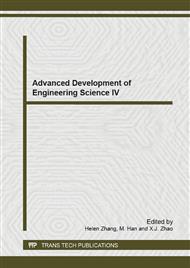[1]
J.R. Bencsik, D Xiao, J.F. Blake, N.C. Kallan, I.S. Mitchell, K.L. Spencer, R. Xu, S.L. Gloor, M. Martinson, T. Risom, R.D. Woessner, F. Dizon, W. Wua, G.P.A. Vigers, B.J. Brandhuber, N.J. Skelton, W.W. Prior, L.J. Murray, Bioorg. Med. Chem. Lett. Vol 20 (2010).
DOI: 10.2210/pdb3qkl/pdb
Google Scholar
[2]
S.F. Barnett, D. Defeo-Jones, S. Fu, P.J. Hancock, K.M. Haskell, R.E. Jones, J.A. Kahana, A.M. Kral, K. Leander, L.L. Lee, J. Malinowski, E.M. McAvoy, D.D. Nahas, R.G. Robinson, H.E.J. Huber, Biochem. Vol 385 (2005), p.399.
DOI: 10.1042/bj20041140
Google Scholar
[3]
S. Masure, B. Haefner, J.J. Wesselink, E. Hoefnagel, E. Mortier, P. Verhasselt, A. Tuytelaars, R. Gordon, A. Richardson, Eur. J. Biochem. Vol. 265 (1999), p.353.
DOI: 10.1046/j.1432-1327.1999.00774.x
Google Scholar
[4]
K.D. Freeman-Cook, C. Autry, G. Borzillo, D. Gordon, E. Barbacci-Tobin, V. Bernardo, D. Briere, T. Clark, M. Corbett, J. Jakubczak, S. Kakar, E. Knauth, B. Lippa, M.J. Luzzio, M. Mansour, G. Martinelli, M. Marx, K. Nelson, J. Pandit, F. Rajamohan, S. Robinson, C. Subramanyam, L. Wei, M. Wythes, and J. Morris, J. Med. Chem. Vol. 53 (2010).
DOI: 10.1021/jm1003842
Google Scholar
[5]
A. Bellacosa, J.R. Testa, S.P. Staal, P.N. Tsichlis, Science Vol. 254 (1991), p.274.
Google Scholar
[6]
D.A. Altomare, J.R. Testa, Oncogene Vol. 24 (2005), p.7455.
Google Scholar
[7]
H. Dudek, S.R. Datta, T.F. Franke, M.J. Birnbaum, R. Yao, G.M. Cooper, R.A. Segal, D.R. Kaplan, M.E. Greenberg, Science Vol. 275 (1997), p.661.
DOI: 10.1126/science.275.5300.661
Google Scholar
[8]
S.J. Wakatsuki, N. Yumoto, K. Komatsu, T. Araki, A. Sehara-Fujisawa, J. Biol. Chem. Vol. 284 (2009), p.2957.
Google Scholar
[9]
T. Hunter, Cell Vol. 88 (1997), p.333.
Google Scholar
[10]
R.J. Vlietstra, D.C.J.G. Van Alewijk, K.G.L. Hermans, G.J. Van Steenbrugge, J. Trapman, Cancer Res. Vol. 58 (1998), p.2720.
Google Scholar
[11]
Z.Q. Yuan, M. Sun, R.I. Feldman, G. Wang, X. -L. Ma, C. Jiang, D. Coppola, S.V. Nicosia, J. Q. Cheng, Oncogene, Vol. 19 (2000), p.2324.
Google Scholar
[12]
K.M. Nicholson, N.G. Anderson, Cell. Signalling Vol. 14 (2002), p.381.
Google Scholar
[13]
J.Q. Cheng, C.W. Lindsley, G.Z. Cheng, H. Yang, S.V. Nicosia, Oncogene Vol. 24 (2005), p.7482.
Google Scholar
[14]
M.H. Sun, S.M. Fuentes, K. Timani, D.Y. Sun, C. Murphy, Y. Lin, A. August, M.N. Teng, and B. He, J. Virol. Vol. 82 (2008), p.105.
Google Scholar
[15]
Q. Sun, R.Z. Wu, S.T. Cai, Y. Lin, L. Sellers, K. Sakamoto, B. He, B.R. Peterson, J. Med. Chem. Vol. 54 (2001), p.1126.
Google Scholar


